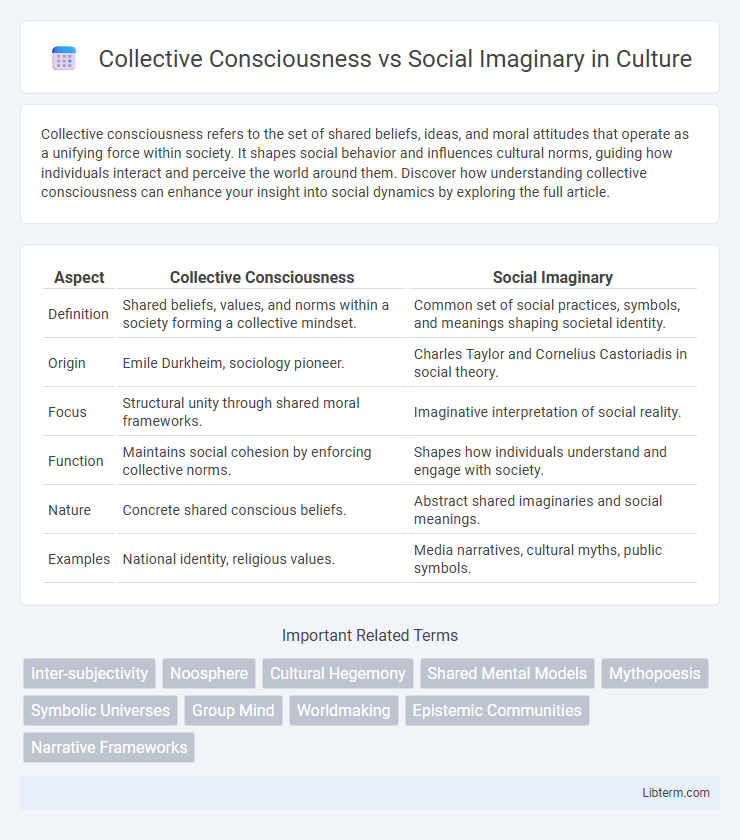Collective consciousness refers to the set of shared beliefs, ideas, and moral attitudes that operate as a unifying force within society. It shapes social behavior and influences cultural norms, guiding how individuals interact and perceive the world around them. Discover how understanding collective consciousness can enhance your insight into social dynamics by exploring the full article.
Table of Comparison
| Aspect | Collective Consciousness | Social Imaginary |
|---|---|---|
| Definition | Shared beliefs, values, and norms within a society forming a collective mindset. | Common set of social practices, symbols, and meanings shaping societal identity. |
| Origin | Emile Durkheim, sociology pioneer. | Charles Taylor and Cornelius Castoriadis in social theory. |
| Focus | Structural unity through shared moral frameworks. | Imaginative interpretation of social reality. |
| Function | Maintains social cohesion by enforcing collective norms. | Shapes how individuals understand and engage with society. |
| Nature | Concrete shared conscious beliefs. | Abstract shared imaginaries and social meanings. |
| Examples | National identity, religious values. | Media narratives, cultural myths, public symbols. |
Defining Collective Consciousness
Collective consciousness refers to the shared beliefs, values, and norms that unify members of a society, originating from Emile Durkheim's sociological theory. It encapsulates the common cognitive framework that shapes social behavior and establishes moral order within a community. Unlike social imaginary, which involves the symbols and narratives people use to understand their social reality, collective consciousness functions as the underlying cohesive force ensuring societal integration.
Understanding Social Imaginary
Social imaginary refers to the shared set of values, symbols, and narratives that shape a community's collective understanding of reality, influencing social practices and institutions. Unlike collective consciousness, which emphasizes common awareness and beliefs among individuals, social imaginary encapsulates the broader cultural framework through which people interpret their social world. Understanding social imaginary is crucial for analyzing how societies construct meaning, coordinate actions, and maintain social cohesion over time.
Historical Origins of Both Concepts
Collective consciousness, coined by Emile Durkheim in the late 19th century, emerged from sociological studies on the shared beliefs and moral attitudes that unify societies. Social imaginary, developed by Charles Taylor in the late 20th century, refers to the common understanding and shared social norms that shape a community's worldview and practices. While collective consciousness emphasizes a collective cognitive framework rooted in social facts, social imaginary focuses on the creative and interpretive dimensions of social life throughout history.
Key Theorists and Philosophical Roots
Emile Durkheim is a central theorist behind collective consciousness, conceptualizing it as the shared beliefs and moral attitudes that unify a society and maintain social order. Charles Taylor and Cornelius Castoriadis are key figures in developing the concept of social imaginary, emphasizing the shared symbols, narratives, and practices through which people make sense of their social world. The philosophical roots of collective consciousness trace back to Durkheim's sociological positivism, while social imaginary draws heavily from phenomenology and postmodern critiques of modernity.
Mechanisms of Formation and Influence
Collective consciousness forms through shared beliefs and values ingrained within a community, driven by repeated social interactions and common emotional experiences that foster group cohesion. Social imaginary emerges from collective narratives, symbols, and practices that shape how societies envision their identity, norms, and future possibilities, upheld through institutions, media, and cultural rituals. Both mechanisms influence individual behaviors and societal structures by embedding meanings that guide perception, decision-making, and social integration at different cognitive and symbolic levels.
Collective Consciousness in Modern Societies
Collective consciousness in modern societies manifests as shared beliefs, values, and norms that unify diverse populations, enabling social cohesion and coordinated action. Rooted in Emile Durkheim's sociological theory, this phenomenon emphasizes the collective awareness that transcends individual perspectives, fostering societal solidarity. Advances in digital communication amplify collective consciousness by accelerating information exchange and shaping public opinion on a global scale.
The Role of Social Imaginary in Shaping Culture
The social imaginary plays a crucial role in shaping culture by providing shared symbols, narratives, and practices that influence collective beliefs and behaviors within societies. It encompasses the collective visions and meanings that individuals use to make sense of their social world, guiding cultural norms and social cohesion. Unlike collective consciousness, which refers to the common awareness among individuals, the social imaginary actively constructs and sustains the cultural framework through which societies interpret reality.
Overlapping Themes and Distinctions
Collective consciousness refers to the shared beliefs and moral attitudes that unify a group, rooted in Durkheim's sociological theory, while social imaginary encompasses the deeper, often unconscious, shared symbols and narratives shaping societal norms as described by Charles Taylor. Both concepts address how individuals internalize group norms and values, but collective consciousness emphasizes concrete, institutionalized practices whereas social imaginary highlights imaginative frameworks sustaining social realities. The overlap lies in their function to bind societies through common meanings, yet their distinction emerges from collective consciousness' focus on explicit social facts and social imaginary's focus on the underlying cultural visions.
Impact on Social Change and Innovation
Collective consciousness shapes social norms and shared values, driving gradual social change through consensus and cultural cohesion. The social imaginary influences innovation by enabling society-wide narratives that reframe possibilities, motivating transformative shifts in technology and social structures. Together, these concepts impact social change by balancing stable cultural identity with dynamic reinterpretations of collective potential.
Towards a Unified Perspective
Collective consciousness, defined as the shared beliefs and moral attitudes of a society, intersects with the social imaginary, which encompasses the symbols, myths, and narratives shaping communal identities. Moving towards a unified perspective involves integrating Emile Durkheim's concept of collective consciousness with Charles Taylor's framework of the social imaginary to understand how societal norms and shared meanings co-evolve. This synthesis enables a comprehensive analysis of how collective identity is constructed through both cognitive consensus and cultural symbolism, facilitating deeper insights into social cohesion and cultural transformation.
Collective Consciousness Infographic

 libterm.com
libterm.com